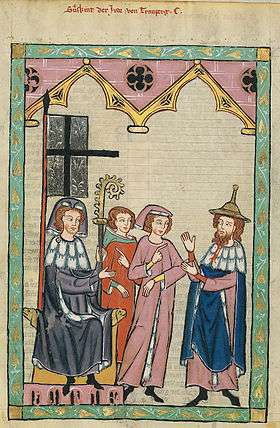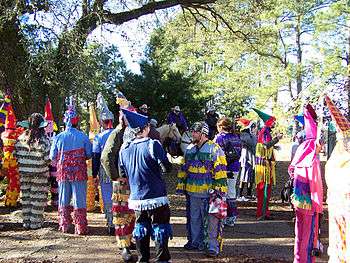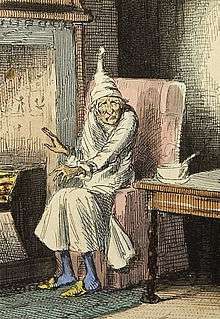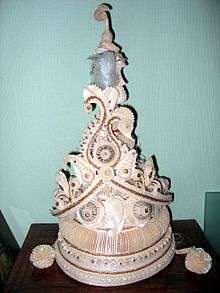Pointed hat

Pointed hats have been a distinctive item of headgear of a wide range of cultures throughout history. Though often suggesting an ancient Indo-European tradition, they were also traditionally worn by women of Lapland, the Japanese, the Mi'kmaq people of Atlantic Canada, and the Huastecs of Veracruz and Aztec (illustrated e.g. in Codex Mendoza). The Kabiri of New Guinea have the diba, a pointed hat glued together.[1]
History
Existence of the conical hat is known as early as the Bronze Age in Middle East and Central Europe. One example is the golden hat worn by members of the priesthood, likely as a ceremonial accessory. In Ancient Greece, the pilos was a common conical traveling hat. Popular among Burgundian noblewomen in the 15th century was a type of conical headgear now called a hennin.[2] Conical hats were also popular in late medieval Vijayanagar, India.
Bronze Age
The conical golden hats of Bronze Age Central Europe were probably a ceremonial accessory worn by the priesthood. See also horned helmet.
Iron Age
Textile analysis of the Tarim Mummies has shown some similarities to the Iron Age civilizations of Europe dating from 800 BC, including woven twill and tartan patterns strikingly similar to tartans from Northern Europe. One unusual find was a distinctively pointed hat:
- Yet another female - her skeleton found beside the remains of a man - still wore a terrifically tall, conical hat just like those we depict on witches riding broomsticks at Halloween or on medieval wizards intent at their magical spells. [3]:200
Pointed hats were also worn in ancient times by Saka (Scythians), and are shown on Hindu temples and in Hittite reliefs. As described by Herodotus, the name of the Scythian tribe of the tigrakhauda (Orthocorybantians) is a bahuvrihi compound literally translating to "people with pointed hats".[4][5]
Besides the Scythians, the Cabeiri as well as Odysseus are traditionally pictured wearing a Pilos, or woolen conical hat.[6]
- Ancient conical hats
-

The Hallstatt culture Warrior of Hirschlanden wears a pointed hat or helmet.
-

Relief in Hattusa, probably depicting Suppiluliuma II.
-

Odysseus wearing a Pilos
Middle Ages

The 13th century Cumans commonly wore pointed hats,[7] and are reported to have fought wearing them.[8]
Originating from the Japanese Heian period, the kazaori eboshi (風折烏帽子) was worn by aristocrats to indicate rank. Still worn today for ceremonial purposes, this black[9] linen hat was used during a samurai's ceremony in attaining manhood.[10]

The Papal tiara in the Middle Ages is sometimes shown as more pointed than in more recent centuries, though also shown with no point. Mitra papalis is a type of conch named after the papal mitre for its form.
Medieval Jewish men wore distinctive headgear as part of their religious observance. This included the pointed Jewish hat (or "Judenhut") already worn by Jews, a piece of clothing probably imported from the Islamic world and perhaps before that from Persia.[11]
Popular among Burgundian noblewomen in the 15th century was a type of conical headgear now called a hennin.[2]
The whirling dervishes from the 13th century wore hats similar to the hennins, and the Ottoman Janissaries wore similar headgear to show their veneration for Hadji Bektash, founder of a Sufi order.
Conical hats were also popular in late medieval Vijayanagar, India.
The term dunce cap is only attested from 1840.
Modern times
The Spitzhut is a traditional kind of headgear in Bavaria.
Pointed hoods were used by various orders and Catholic lay confraternities for processions, e.g. the Semana Santa of Sevilla who wore the Capirote.
Pointed hats are still worn in the rural Louisiana Mardi Gras celebrations by the Cajuns, the Courir de Mardi Gras, where they are known as capuchons.[12]
The Ku Klux Klan has worn this headgear since its first era, where the costumes were far more elaborate than the modern, plain attire.
Folklore and fiction
Classical pointed hats are worn by the dwarfs, witches and wizards of European Folklore.
Also seen on: Garden gnomes, Smurfs, Gandalf, Merlin, and Link.
Types
| Type | Image | Notes |
|---|---|---|
| Bashlyk | This traditional Turkic and Cossack cone-shaped headdress hood is usually made of leather, felt or wool. It is an ancient round topped felt bonnet with lappets for wrapping around the neck. | |
| Capirote | _in_the_Holy_Week_parade_in_Granada_(IMG_5519a).jpg) |
Historically, the capirote was a cardboard cone worn in Spain. |
| Capuchon |  |
A capuchon is a ceremonial hat worn during the Mardi Gras celebration in the Cajun areas of southwestern Louisiana, known as the Courir de Mardi Gras. |
| Asian conical hat |  |
Known as a sedge hat, rice hat, paddy hat or coolie hat, this simple style of hat is often made of straw. It originated in East, South and Southeast Asia, particularly Vietnam, China, Japan, Korea, Cambodia, Philippines, India, Bangladesh and Indonesia. |
| Dunce cap |  |
In popular culture, the dunce cap is typically made of paper and often marked with a D or the word "dunce", and given to schoolchildren to wear as punishment by public humiliation for misbehaviour and, as the name implies, stupidity. |
| Golden hat | _2010-12-19_054.jpg) |
This type of hat is a very specific and rare type of archaeological artifact from Bronze Age Europe. |
| Hennin |  |
Most commonly worn in Burgundy and France by women of the nobility, the hennin appears from about 1430 onwards. Later, though, this hat spread more widely, especially in the truncated form. Typically, the hennin was 12 to 18 inches (30 to 45 cm) high, generally accompanied by a veil that usually emerged from the top of the cone and was allowed to fall onto the woman's shoulders. |
| Hogeon |  |
This Korean traditional headgear for young boys aged one year to five years has flaps, and is a type of gwanmo (관모),. |
| Jewish hat |  |
The Jewish hat was often white or yellow, worn by Jews in Medieval Europe and some of the Islamic world. |
| Kalpak |  |
This high-crowned cap is usually made of felt or sheepskin. It is worn by men from southeastern Europe, Iran, Central Asia and the Caucasus. |
| Kasa | |
A Kasa is any of several kinds of traditional hats of Japan. |
| Nightcap |  |
This garment is worn while sleeping, often with a nightgown, for warmth. |
| Party hat | |
A party hat is generally a playful conical hat made with a rolled up piece of thin cardboard, usually with designs printed on the outside and a long string of elastic going from one side of the cone's bottom to another to secure the cone to one's head. |
| Phrygian cap |  |
The Phrygian cap is a soft cap with the top pulled forward. Associated in antiquity with the inhabitants of Phrygia, a region of central Anatolia; from the French Revolution a symbol of revolution, liberty and republicanism - and in modern times with Smurfs. |
| Pileus |  |
The pileus was, in Ancient Greece and Rome, a brimless, felt cap, somewhat similar to a fez. |
| Salakot |  |
Usually made from rattan or reeds, this is a traditional hat from the Philippines. |
| Sugar loaf |  |
This very tall, tapering hat was first worn in medieval times. Its name comes from the loaves into which sugar was formed at that time.[13] The sugar loaf hat is a kind of early top hat ending in a slightly rounded conical top.[14] |
| Tantour |  |
Similar to the hennin, this woman's headdress was popular in the Eastern Mediterranean during the 19th century.[15][16] The most ornate tantours were made of gold and reached as high as 30 inches. Some were encrusted with gems and pearls. The tantour was held in by a ribbons tied around the head. A silk scarf was wound around the base with a white veil attached to the peak.[17] |
| Topor |  |
A topor is worn during Bengali Hindu wedding ceremonies. It is usually white, fragile, and made of sholapith. |
See also
References
- ↑ Angeleimter Spitzhut oder "diba" Kabiri (Neuguinea) (German)
- 1 2 hat — FactMonster.com
- ↑ Elizabeth Wayland Barber (2000). The Mummies of Ürümchi. W. W. Norton, Incorporated. ISBN 978-0-393-32019-0.
- ↑ Lendering, Jona (2013). "History of Iran: Scythians / Sacae". Iran Chamber Society. Retrieved 12 December 2013.
The Sakâ tigrakhaudâ ('Sacae with pointed hats') were defeated in 520/519 BCE by the Persian king Darius I, who gave this tribe a new leader. One of the earlier leaders was killed, the other, named Skunkha, was taken captive and is visible on the relief at Behistun. (It is possible that Darius created a new tribe from several earlier tribes.) Herodotus calls the Sakâ tigrakhaudâ the Orthocorybantians ('pointed hat men'), and informs us that they lived in the same tax district as the Medes. This suggests that the Sakâ tigrakhaudâ lived on the banks of the ancient lower reaches of the Amudar'ya, which used to have a mouth in the Caspian Sea south of Krasnovodsk. The pointed hat is a kind of turban.
- ↑ Askolʹd Igorevich Ivanchik; Vaxtang Ličʻeli (2007). Achaemenid Culture and Local Traditions in Anatolia, Southern Caucasus and Iran: New Discoveries. BRILL. pp. 19–. ISBN 978-90-04-16328-7.
- ↑ Walter Burkert (1 January 1983). Burkert. University of California Press. pp. 133–. ISBN 978-0-520-03650-5.
- ↑ Linehan, Peter; Nelson, Janet Laughland, eds. (2003). The medieval world. Routledge Worlds Series 10. Routledge. pp. 82–83. ISBN 978-0-415-30234-0.
- ↑ Karasulas, Antoly (2004). Mounted archers of the Steppe 600 BC-AD 1300. Illustrated by Angus McBride. Osprey Publishing. p. 63.
[The warrior's] conical fur-edged felt hat is a typical item of Cuman clothing
- ↑ "Japan Regional Information". Asia-planet.net. Retrieved 2010-08-16.
- ↑ "冠と烏帽子". Kariginu.jp. Retrieved 2010-08-16.
- ↑ Jewish hat article
- ↑ "Mardi Gras in Rural Acadiana". Retrieved 2010-02-18.
- ↑ "Types of hats Alphabetic List N - Z". Millinerytechniques.com. Retrieved 2010-08-16.
- ↑ Sewell, Charlotte (1983). Clothes in History. Wayland Ltd. Pp. 20, 21
- ↑ 19th Century Lebanese Princess
- ↑ "The Tantour or Shihabbiyeen". Trmkt.com. Retrieved 2010-08-16.
- ↑ "Origin of Levantine Costumes". Almashriq.hiof.no. Retrieved 2010-08-16.
Additional reading
- Barber, A.W. (1999). The Mummies of Ürümchi. Macmillan, London.
_-_Foto_Giovanni_Dall'Orto%2C_10_june_2011.jpg)